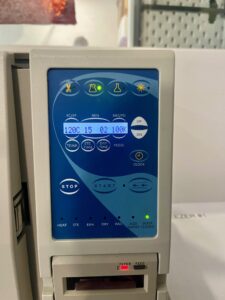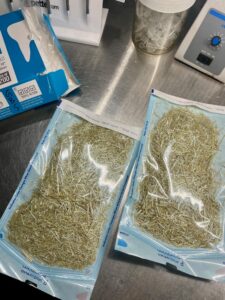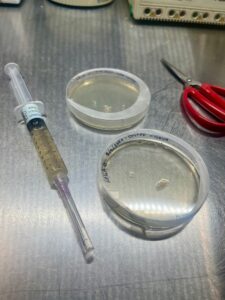Week 7: Autoclave Pouches, Inoculating Straw, DIY Laminar Flow Hood
May 10, 2024
Welcome to Week 7!
To begin this week, I started by autoclaving the straw that I was going to inoculate with the liquid culture (see Figure 1). This was different from the previous time I had used the autoclave machine; for the agar plates, which started as a liquid medium, I used a beaker. This time, however, I had to use autoclave pouches (see Figure 2). An autoclave pouch is a specialized packaging designed to hold items during the autoclave sterilization process. These pouches are typically made of heat-resistant materials, such as medical-grade paper or plastic, that can withstand the high temperatures and pressures of autoclaving (see Figure 3).

Once the straw was ready (there’s an indicator on the pouch to ensure it got properly sterilized), I cleaned a ziploc bag and transferred it from the pouches to the bag. Inoculating the substrate in a ziploc bag is an unorthodox method – most people use jars or grain spawn bags with a paper filter, so we’ll see if the ziploc bag method works! I worked quickly to try to minimize the risk of contamination, using the liquid syringe, adding a couple spoonfuls of flour and distilled water to help provide additional nutrients for the mycelium to grow, shaking the bag to try to make sure the inoculant was evenly distributed, and poking small holes to facilitate gas exchange. I placed the bag in a dark, warm place, and am monitoring it for signs of growth or contamination.


Another project I worked on this week was trying to make my own makeshift sterile hood, also known as a laminar flow hood. Because the one at Genspace is in use, I’m going to try to set one up in my home. While a DIY sterile hood may not achieve the same level of sterility and control as a professional-grade laminar flow hood, it can still provide a relatively clean environment. I set up a physical barrier around my workspace to minimize airflow and reduce the risk of contamination, cleaned and sterilized all surfaces using alcohol as a disinfectant solution, and placed a portable HEPA air purifier near my workspace to help filter out airborne contaminants.
Finally, I spent part of this week cleaning off a glass paint palette I already own, which I plan on using as a surface for the paint making!
See you next week!
Reader Interactions
Comments
Leave a Reply
You must be logged in to post a comment.

The use of a different culture and syringe to grow more mycelium is super interesting, I’m curious about which method for growing mycelium you think is the most effective and scalable.
Not sure yet – we’ll see which one works!